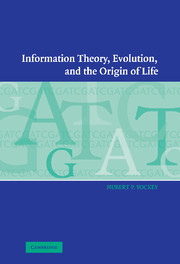Book contents
- Frontmatter
- Contents
- Preface
- 1 The genetic information system
- 2 James Watson, Francis Crick, George Gamow, and the genetic code
- 3 The Central Dogma of molecular biology
- 4 The measure of the information content in the genetic message
- 5 Communication of information from the genome to the proteome
- 6 The information content or complexity of protein families
- 7 Evolution of the genetic code and its modern characteristics
- 8 Haeckel's Urschleim and the role of the Central Dogma in the origin of life
- 9 Philosophical approaches to the origin of life
- 10 The error catastrophe and the hypercycles of Eigen and Schuster
- 11 Randomness, complexity, the unknowable, and the impossible
- 12 Does evolution need an intelligent designer?
- 13 Epilogue
- Mathematical appendix
- Glossary
- References
- Index
6 - The information content or complexity of protein families
Published online by Cambridge University Press: 15 August 2009
- Frontmatter
- Contents
- Preface
- 1 The genetic information system
- 2 James Watson, Francis Crick, George Gamow, and the genetic code
- 3 The Central Dogma of molecular biology
- 4 The measure of the information content in the genetic message
- 5 Communication of information from the genome to the proteome
- 6 The information content or complexity of protein families
- 7 Evolution of the genetic code and its modern characteristics
- 8 Haeckel's Urschleim and the role of the Central Dogma in the origin of life
- 9 Philosophical approaches to the origin of life
- 10 The error catastrophe and the hypercycles of Eigen and Schuster
- 11 Randomness, complexity, the unknowable, and the impossible
- 12 Does evolution need an intelligent designer?
- 13 Epilogue
- Mathematical appendix
- Glossary
- References
- Index
Summary
We have only begun to appreciate the tremendous amount of biological information implicit in the biochemistry of living organisms.
M. O. Dayhoff and R. V. Eck (1978)The information content or complexity of an homologous protein family
Functionally equivalent amino acids
The specificity of proteins is determined, not only by the amino acid sequence, but also by the active pocket of amino acids that contains metal ions such as iron, zinc, copper and manganese (Thompson and Orvig, 2003). Thyroxine, which contains iodine, is the major hormone secreted by the thyroid gland. Thyroid gland deficiency disease is very common, especially in women.
Some substitutions of amino acids at certain sites may have a destabilizing effect on the protein-folding pathways. Thus, the selectivity of amino acids is determined by the primary role played in the protein folding process as well as by the requirements of the activity of the completed and folded molecule (Hoang et al., 2002). Proteins that misfold can form extracellular or intracellular aggregates, resulting in disastrous cellular dysfunction. Human protein-folding disorders include Alzheimer's and Parkinson's diseases (Selkoe, 2003).
The sequence hypothesis of Watson and Crick and Shannon's information theory
We now are able to address the application of Shannon's information theory to the sequence hypothesis of Watson and Crick. Usually in the olive groves of academe, suggestions from other departments are not received gladly. Nevertheless, Gamow's proposal that the sequence hypothesis could bring biology over into the group of the exact sciences could not be ignored.
- Type
- Chapter
- Information
- Information Theory, Evolution, and the Origin of Life , pp. 57 - 92Publisher: Cambridge University PressPrint publication year: 2005



